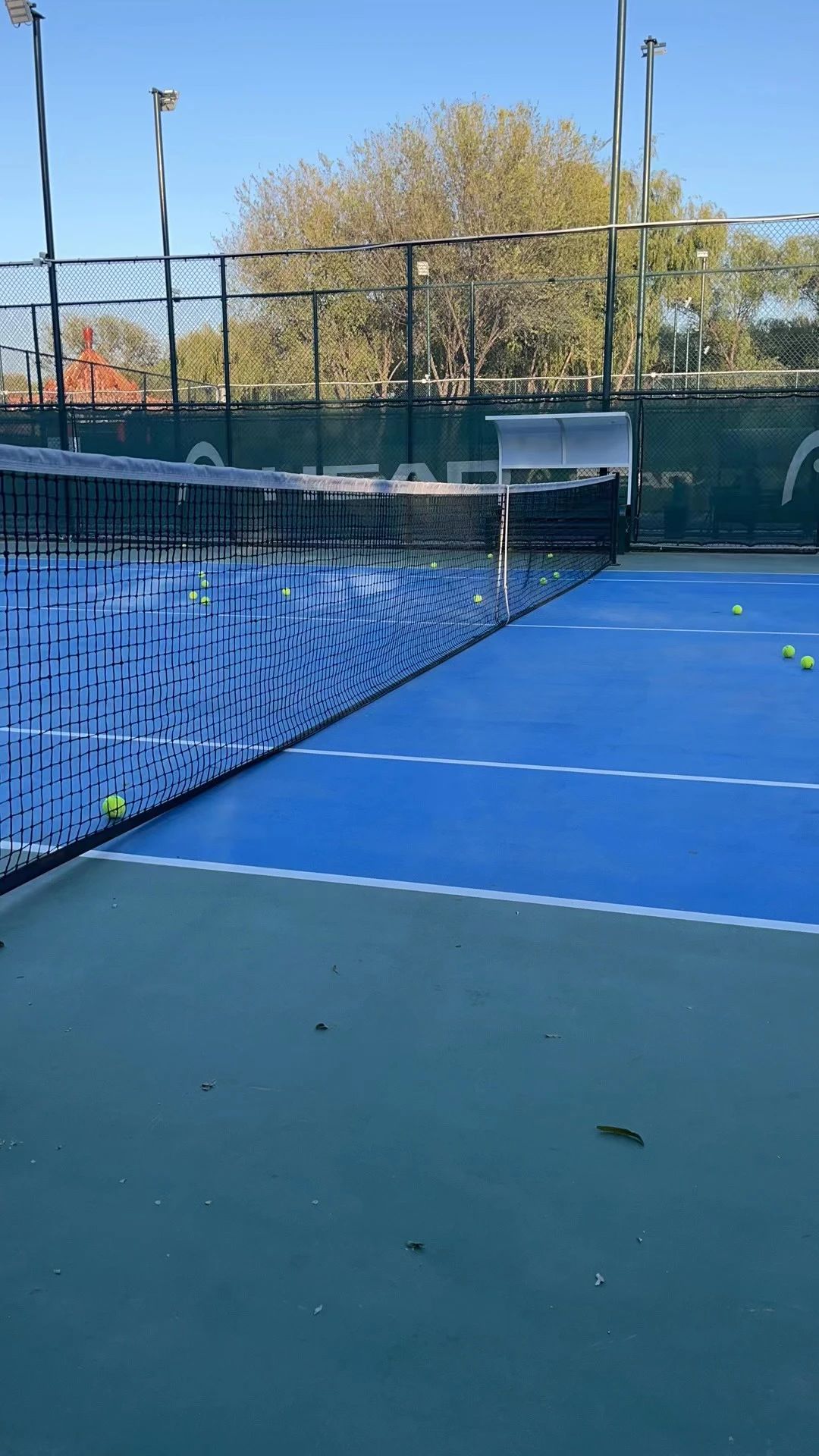Watching the ball requires "binocular coordination," not relying on a "dominant eye."

"All articles in the 'Translation into a Forest' column are sourced from foreign-language translations and are not marked as original works. If you believe any content infringes on your rights, please contact us for removal."
01
Material Introduction
In this video, Dr. Laby provides an in-depth introduction to the concept of the dominant eye (also known as the preferred eye).
The concept of the dominant eye has become a widely discussed topic in the field of sports vision—and it’s been heavily promoted by the media.
You might have questions like these—just which of your eyes is your dominant eye?
Is the relationship between the dominant eye and the dominant hand consistent, or is it crossed?
Is the dominant eye of a left-handed person actually the left hand—or the right?
Can applying the concept of the dominant eye truly enhance athletic performance?
Dr. Laby breaks down the ongoing debate about the dominant eye in this video, offering explanations for two key questions—both through literature review and scientific analysis.
First, why using the dominant eye during sports is simply a matter of athletes' personal preference;
Second, the concept of a dominant eye plays a minimal role in most sports—except for activities that require precise aiming, such as shooting or archery.
02
Dr. Laby's Self-Introduction
Hello everyone, I’m Dr. Laby. I’ve been collaborating with professional and elite athletes in the field of sports vision for over 30 years.
I’d like to share the experience and knowledge I’ve gained from my work with you, helping you enhance or maximize your athletic performance through the lens of sports vision.
In this session, we'll delve deeper into the issue of "visual dominance."
We are primarily focusing on two issues:First, how do you test the dominant eye?
Second, is the concept of a dominant eye important for improving performance in various sports?
03
The origin of the concept of the dominant eye
The idea that humans might have a dominant eye likely emerged around 500 years ago—and at the time, it seemed perfectly reasonable to people.
Their conclusion stems from the following analysis:
Since some people are accustomed to using their left hand, while others prefer their right,We categorize humans into two groups—“left-handed” and “right-handed”—in this way. Similarly, people are likely more accustomed to using either their left or right eye, and relying on their dominant eye when performing different tasks can provide a distinct advantage.
04
Hands and eyes are different.
Although the "dominant-hand theory" is clearly effective—since two hands can work independently to perform different tasks (and we typically use our dominant hand for more complex ones)—
However,The proof of the dominant eye theory doesn't stem directly from factual analysis—it is instead derived through speculation.
If you believe that "humans have a dominant hand" makes sense—and that we’re capable of using both hands independently. (For example, we can hold something in one hand while writing with the other.)
This idea is perfectly fine and highly intuitive, but when we talk about eyes, the situation is different.
We’re actually accustomed to using both eyes simultaneously for observation—it’s not something we can do with just one eye at a time.
If one of your eyes is looking in one direction while the other eye is focused in a different direction, it’s time to see a doctor to find out exactly what’s going on with your eyes.
05
Eyes are accustomed to working in coordination.
In addition to the reasons mentioned above,Coordinating the use of both eyes allows us to achieve ideal, perfect stereoscopic depth perception.
If one of our eyes develops a problem when focusing on objects, our ability to perceive depth in 3D is diminished.
I've already explained it in other videos,The crucial role that 3D vision and stereoscopic vision play in athletic performance.
We use our left and right hands to perform different tasks—usually holding a phone or book in one hand while writing with the other—but we can’t actually focus our left and right eyes separately.
In fact,If our two eyes look in different directions when focusing on an object, it not only leads to a lack of depth perception but also causes double vision.
Clearly, none of us want to experience double vision while exercising. That’s why the “dominant-eye theory” is certainly not as seamless as the “dominant-hand theory”—the former has its own set of issues.
06
Issues with the dominant eye testing method
First, let’s analyze the different methods for testing dominant eyes. I don’t want to list every single one here—after all, there are nearly 40 to 50 of them!
However, broadly speaking, we can categorize these methods into two groups.
The first type of test aims to obtain a precise result regarding monocular dominance.This test will only yield a definitive answer indicating whether the tester’s left or right eye is the dominant one, ruling out the possibility that dominance might exist between both eyes.
The second type of test suggests that our visual dominance when viewing objects can lie either in the left eye, the right eye, or even somewhere between the two.
Let me clarify in advance: in reality, when we look at objects, we don’t actually favor using either our left or right eye—there’s no inherent visual dominance.
Let's analyze this below:
If we conduct the first-type test, in this scenario, even individuals who use both eyes together will only be able to conclude whether their "left eye or right eye is the dominant one."
The results of this type of test depend on our hands—perhaps the most typical example being the "paper-piercing test."
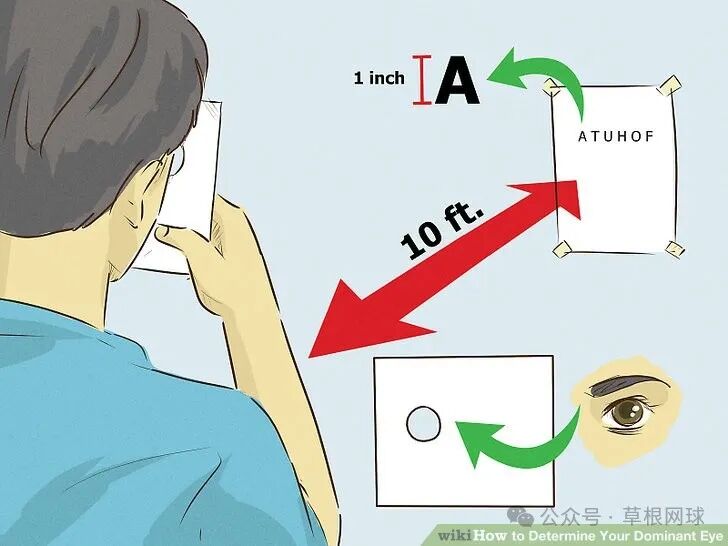
A simplified version of the paper-hole test is widely used: Simply bring your hands together to simulate a sheet of paper, leaving a small hole in the middle. Then, look at an object through the hole with both eyes. Next, cover each eye one at a time—if, when covering one eye, the object becomes hidden behind your hand, that eye is your dominant (or "main") eye.
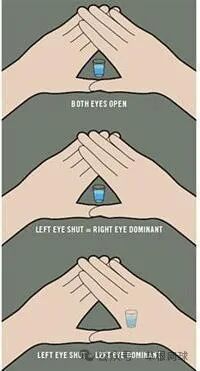
In the first type of test, if your shoulder movement is restricted or your arm is injured, you’ll involuntarily lean to one side, forcing you to rely on either your left or right eye for vision. In such cases, the test results won’t accurately reflect your true visual capabilities.
Further speaking,When forced to choose between using the left or right eye for vision due to reasons unrelated to the eyes themselves, the test results are inaccurate.
It is clear from this that the Type 1 monocular vision test is not a reliable method for determining the dominant eye.
Now let's analyze.The second test, we can draw an analogy to the method used for measuring water temperature.
We need a thermometer to determine whether the water is hot or cold. The thermometer is calibrated with distinct markings ranging from the freezing point of 0 degrees up to 100 degrees, allowing it to accurately measure the water's temperature based on these scales.
The second method involves measuring the dominant eye position by testing water temperature, marking precise scales between the two eyes, and using numerical values to determine whether the left or right eye is the dominant one—or if the dominant position lies somewhere in between the two eyes.
This type of quantitative testing method seems to be more meaningful than simple qualitative tests.
Compared to simply concluding whether "water is hot or cold," the quantitative temperature-measuring method not only tells you whether the water feels hot or cool—but also allows you to assess, based on your own comfort level, whether the water is too hot or too cold. While individual perceptions may vary, temperature itself remains an objective reality.
07
One of the studies: Comparing Different Dominant Eye Testing Methods
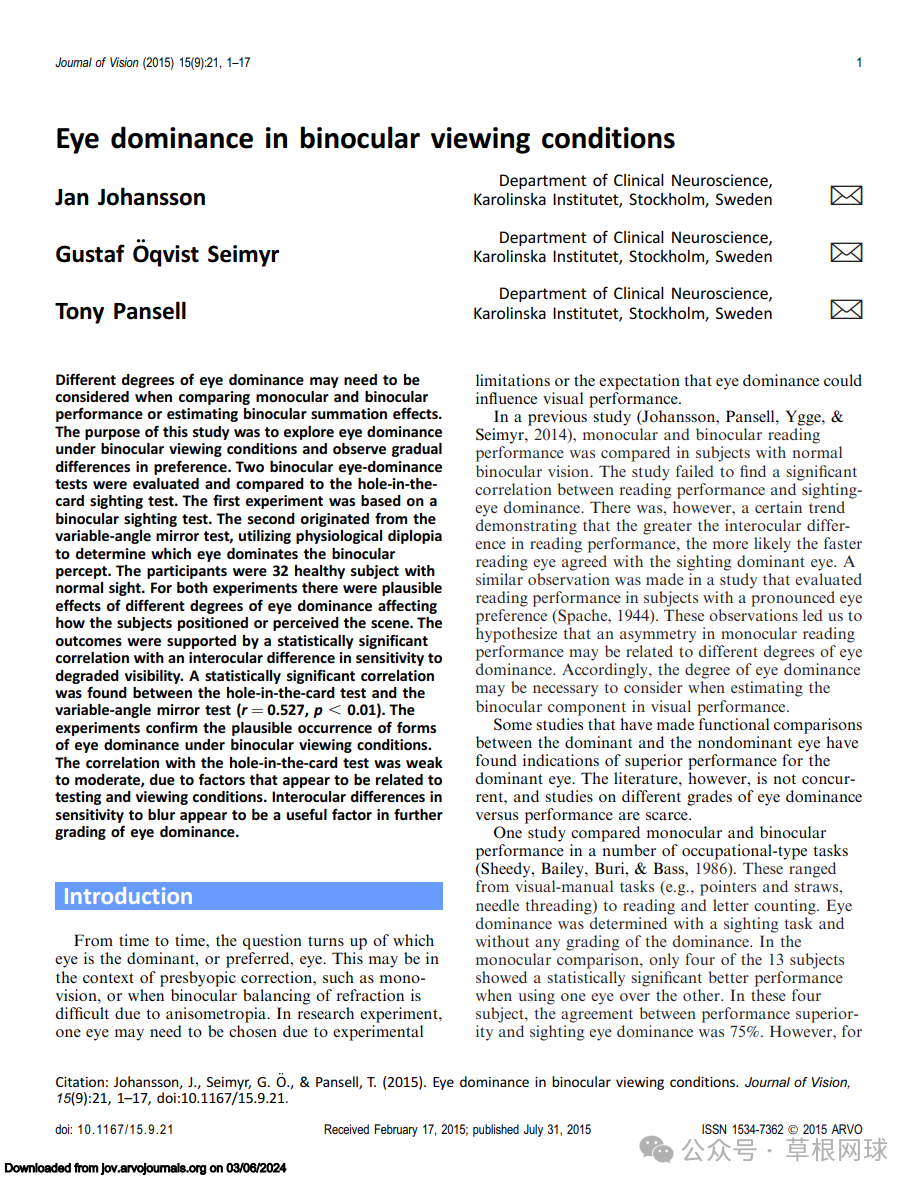
In a 2015 study by Swedish scientists, they compared the two types of tests: one could only determine whether the left or right eye was the dominant eye, while the other provided an intermediate value reflecting the balance between the two eyes.
Their research findings align with our expectations: the two testing methods yielded completely unrelated results (results from the same subject tested using different methods were inconsistent).
(Translator's note: On a quick read, Swedish scientists tested 32 participants using two categories of three methods each. Ultimately, the different approaches yielded conflicting conclusions.)
The subjects did not exhibit a clear dominant eye effect; which eye they relied on more for vision depended primarily on the visual conditions.)
In this study, some participants were left-handed, while others were right-handed, or slightly left- or right-dominant—and there were even participants who used only their left hand—but nevertheless,"The dominant-hand variable had no impact whatsoever on the results of either test."
Keeping other variables constant, when participants were allowed to freely choose between left and right, 28 out of the 32 subjects reported no dominant eye preference—they simply perceived their eyes as equally balanced in terms of visual dominance.
ButIf subjects are forced to choose left or right, it leads to a different conclusion: the subjects' dominant eye shows a clear preference.
08
Study No. 2: Different testing methods lead to different conclusions
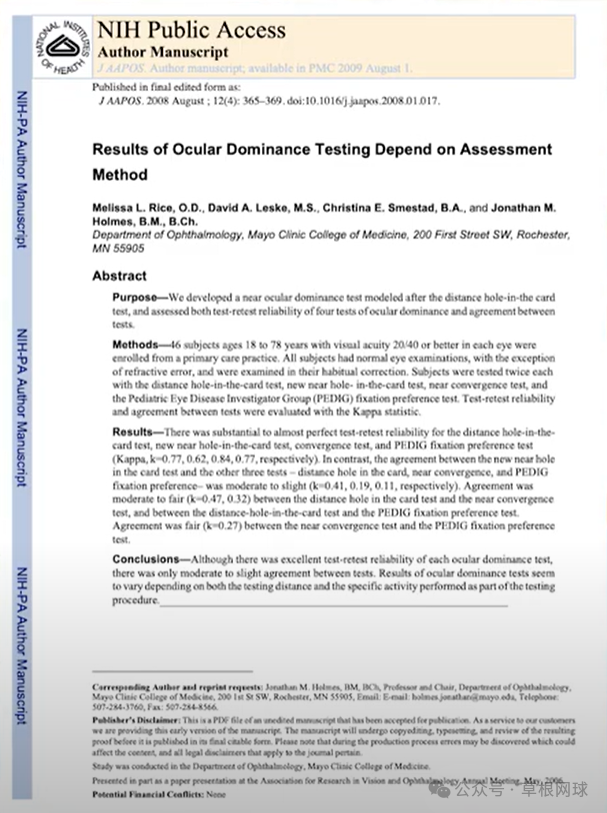
In a paper from the Mayo Clinic, we found a similar conclusion.
When exploring different testing methods, researchers first examined the reliability of these tests.
There's no doubt that these testing methods are highly reliable—in other words, when these methods are used, a second, repeated experiment will yield the exact same results as the first.
Experimental reliability is crucial for assessing the feasibility of a testing method—high reliability indicates that there are no issues with the method's design.
But unfortunately,The final conclusion is that there is no real correlation between the test results of the two methods, as the same subjects yielded different dominant eye outcomes.
Another study conducted in Canada showed that the test results for participants' dominant eyes depended on the viewing distance.
In the test, the same subject produced different dominant eye results simply by changing the testing distance.
This clearly shows that these testing methods seem to have significant issues—changing either the test method or the testing distance for the same subject can lead to entirely different conclusions about the dominant eye.
Currently, existing dominant-eye tests all have certain potential issues, and the actual conclusions regarding the practical effectiveness of the "dominant-eye theory" remain somewhat unsatisfactory.
If the same subject is tested multiple times, yet each test yields a different conclusion, such a test is meaningless.
09
Study Three: The advantages we perceive may simply be a matter of preference.
In factIn our recent paper, the researchers thoroughly explored the visual advantage and explained that what we perceive as an advantage is actually just a preference.
This paper revisits the historical origins of the "visual dominance" hypothesis, first proposed 500 years ago, and explores—through both physiological analysis and mechanical experimentation—whether this "visual advantage" actually plays a role.
Additionally, we examined several distinct fallacies that have been cited by others to support the idea of "either purely the left eye or the right eye being the dominant eye"—fallacies that rely exclusively on the results of monocular tests as evidence, which are hardly convincing.
10
The Internet's rampant promotion of the dominant eye
Despite the abundance of literature addressing "visual superiority," issues with the "visual superiority" testing method, and the claim that "visual superiority" doesn't exist at all.
ButThe concept of leveraging "visual dominance" has now gained widespread traction in the sports world, and the audience exposed to misinformation continues to expand.
Nowadays, many sports coaches and eye care specialists are also using "visual dominance" as a key tool for assessing athletic performance.
Below are some video clips captured from YouTube, in which the creators not only explain how to conduct the "visual superiority" test but also vividly demonstrate their firm belief in the "visual superiority" theory.
Now let's take a look at their pitch:
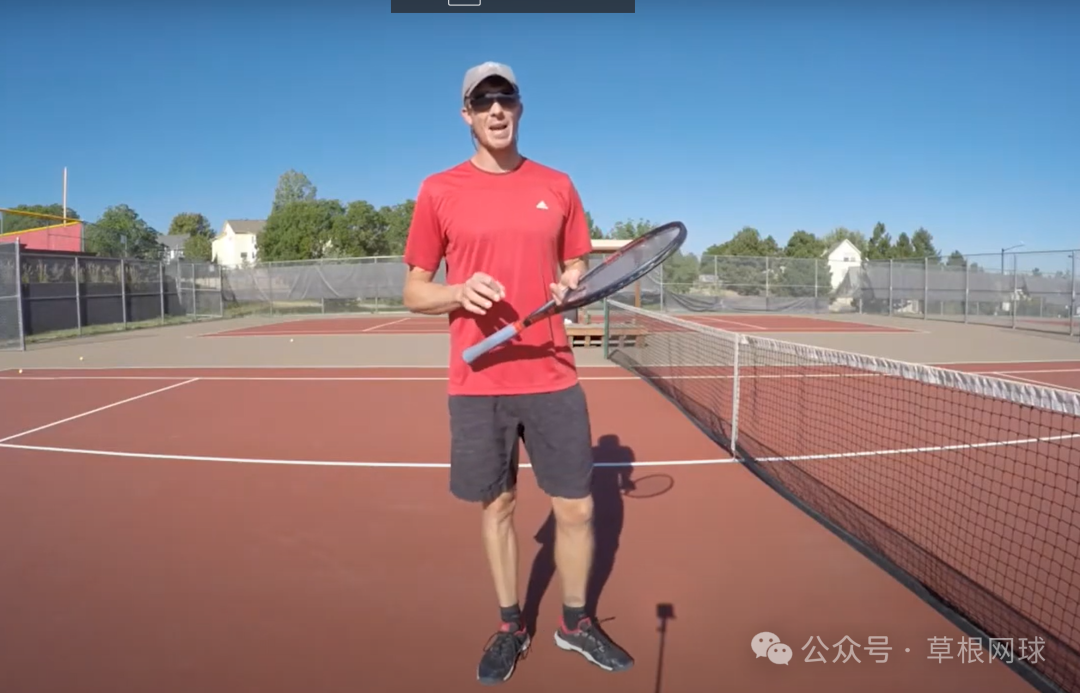
A tennis coach on YouTube
The tennis coach said at the beginning of the video:
Today, I’ll walk you through exactly what “visual dominance” means, and we’ll even do a few dominant-eye tests to determine which eye is your "dominant eye."
I don’t know if you’ve ever taken tests like these before, but they’ve been a huge help in improving my tennis skills.
I'll explain in the latter half of the video how I use the "dominant eye theory" to tackle the challenge of tracking the ball—whether I'm on the forehand or backhand side.
(Translator's note: After hearing this personal description, can we really trust what this tennis coach has to say?)
Perhaps overcoming the hurdle of "easily trusting" is the first obstacle that amateur tennis enthusiasts should tackle.
Focus on the group, not individual cases; prioritize analysis over blind conformity; embrace science, not mysticism!

A certain ophthalmologist on YouTube
The person, who claimed to be an ophthalmologist, said as follows:
In this video, I’ll first walk you through how to perform the "dominant eye test," and then help you determine which of your eyes is your dominant one by taking the test.
It's very important for all of us to know exactly which eye is our "dominant eye."
At least for me, as an ophthalmologist, I need to know precisely which of the patient’s eyes is the "dominant eye."
(Translator's Note:In the age of self-media, anyone can come forward to share their opinions. Should we trust blindly?)
11
Argument Summary
So, how should we respond to the scientific community's dismissal of the "dominant eye," as well as the media's extensive promotion of it?
Simply put,We already know that the "dominant eye" theory was proposed because people speculated it was related to the "dominant hand" theory. However, while the "dominant hand" theory makes sense in certain situations, the "dominant eye" theory simply doesn’t hold up at all.
Assuming the existence of the "dominant eye" effect—where individuals tend to rely more heavily on either their left or right eye—this can impact the visual functions of both eyes. Under this assumption, we lose the benefits of coordinated binocular vision (specifically, the ability to perceive stereoscopic depth).
Currently, the dominant-eye theory has the following two issues:
On the one hand, we have many "dominant eye" testing methods, but the dominant eye measured by the same person can vary depending on the method used.
On the other hand, we found that in any given test, the same person’s dominant eye can vary depending on the distance at which the measurement is taken.
12
Major League Baseball (MLB)
A Study on the Dominant Eye of Batters
A few years ago, we published a study analyzing the batting performance of major-league baseball players.
This article primarily measures a batter's performance using three sets of statistics: batting average, slugging percentage, and on-base percentage.
We first determine the players' "dominant eye" through testing. Then, we divide the batters into two groups: one consisting of players with "hand-eye coordination," and the other including those with "crossed hand-eye coordination." Specifically, in the hand-eye coordination group, right-handed players whose dominant eye is their right eye; in the crossed hand-eye coordination group, right-handed players whose dominant eye is their left eye.
Our final conclusion is that, whether it’s “crossed hands and eyes” or “aligned hands and eyes,” their three sets of data are remarkably similar. (Players do not gain an advantage simply because they have a "dominant eye" that differs from others.)
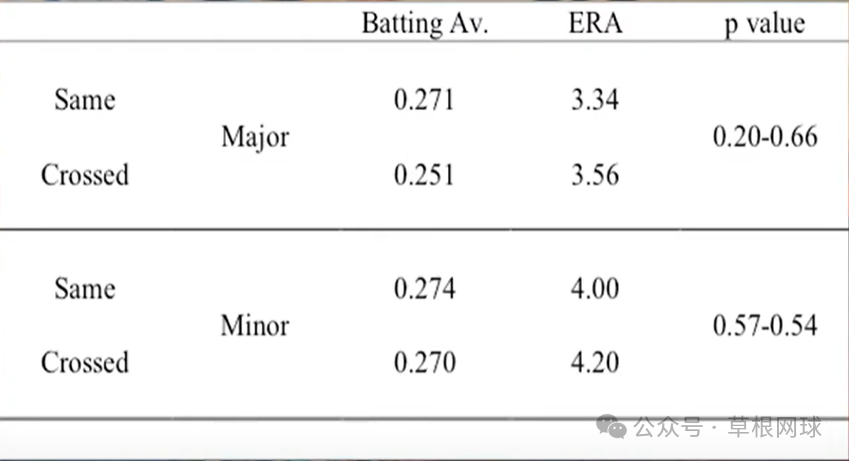
The athletes' performance on the field
Now we can conclude,In sports that require focusing on the ball, such as baseball or tennis, the coordinated function of both eyes is crucial.
There are certain sports where your dominant eye can make a significant difference—such as in archery.In this sport, where athletes must focus their gaze on the target using just one eye at a time, determining which eye serves as the dominant eye is a critically important issue. Archers often spend considerable time identifying which eye provides the clearest view of both the sight and the target.
13
Conclusion
In this video, we explore the truth behind the "visual superiority" theory and gain a clear understanding.Using both eyes in coordination is the best way to achieve stereoscopic depth perception, highlighting why athletes rely on the synchronized use of their eyes—and how this enhances their ability to gather critical visual information during performance.
For us, understanding the visual demands of each sport is crucial. Only when athletes truly grasp these visual needs can they effectively use sports vision tools to enhance their performance. Thank you all for watching!
14
Training Philosophy
For the vast majority of tennis enthusiasts, the most frustrating issue is often not the lack of tennis training information—but rather being bombarded with too much advice in the digital age, leaving them utterly unable to distinguish between what’s helpful and what’s misleading, ultimately trapping them in a never-ending cycle of trial and error.
"What information should we actually trust?" Addressing this philosophical question is equally relevant when it comes to correctly acquiring training data.
Should we believe that using your dominant eye can enhance athletic performance?


